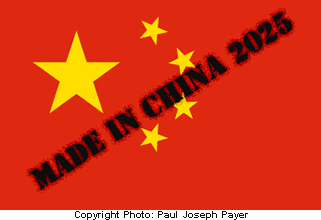
Why West Fears ‘Made in China: 2025’
By F. William Engdahl
3 August 2018
The Trump administration has made the Chinese industrial transformation strategy, “Made in China: 2025,” or simply China 2025 the explicit target of its current trade war offensive against the Peoples’ Republic. Western industrial leading countries, including Germany, are understandably alarmed. Only they are ten years late, and until now have foolishly refused to collaborate with China in key developments, including of the new economic Silk Road or Belt Road Initiative. Here I want to briefly indicate what China is doing. In future reports I will discuss some fundamental flaws in their industrial strategy. Here it is important to understand what China 2025 signals to Western industrial domination .
When he took office, China President Xi Jinping moved to propose what is now the Belt and Road Initiative, a comprehensive network of new infrastructure projects going from China across Asia and Eurasia to the Middle East and the European Union. Xi proposed the BRI at a meeting in Kazakhstan in 2013. Then in 2015, after little more than two years in office, Xi Jinping endorsed a comprehensive national industrial strategy, Made in China: 2025. China 2025 replaced an earlier document that had been formulated with the World Bank and the USA under Robert Zoellick.
One quality I’ve come to appreciate from first hand observation over the course of numerous visits and discussions across China since 2008 is the remarkable determination of Chinese institutions and people, once a national strategy consensus is agreed, to realize that with almost a ruthless determination. Mistakes have been made, in the rush to go from one of the world’s most impoverished peasant economies to the world’s largest industrial producer. Quality control often has been secondary priority. However, step by step since Deng’s 1979 “Socialism with Chinese Characteristics” policy turn, China has emerged to become the literal workshop of the world. Until now it has been producing on license for Western multinationals such as VW or Buick GM cars, iPhones or MacBooks, or countless other products for Western multinationals.
“Rejuvenating Chinese manufacturing”
Now China is changing that. Much as Japan did after 1952 then later South Korea embracing the Japanese example, and more relevantly Germany after 1871, China is going to what they describe as “rejuvenating Chinese manufacturing.” This, translated, means instead of being the workshop assembling components for foreign giants like Apple, China will develop its own Apple, or BMW or G5. They have begun a new phase in development of their own world leading industry. Now as China 2025 says, the national industry and government institutions supporting that is undergoing a “transformation from Made in China to Created in China, from China Speed to China Quality, and from Chinese products to Chinese brands.” The broad concept for China 2025 has been modelled on the German “Industry 4.0” strategy which some call the 4th Industrial Revolution. It aims to utilize technological advances in key technologies such as artificial intelligence, internet of things, machine learning, cloud systems, cybersecurity, adaptive robotics to cause radical changes in the business processes of organizations. China has now made such concepts national strategic priority in its economic future development. It is no minor deal. And that is precisely why Trump advisers with their trade war actions are targeting precisely the key vulnerabilities and links to western technologies such as those of China telecom giants Huawei or ZTE Telecommunications which are still dependent on US chips and other sensitive technologies.
‘Post Industrial’ USA
Beginning in the 1970’s there was a deliberate strategy among major US multinational companies to move their manufacture abroad in search of cheap labor, low costs. US think tanks and journals praised the nonsensical idea that the West had entered a “post-industrial era,” a promised nirvana where instead of “dirty” industrial jobs in steel, autos and such, the future would be a services economy. In reality it was outsourcing of America’s manufacturing base.
Beginning especially in the 1990’s with China’s negotiations to join the Western industrial “club” by negotiating for WTO membership, corporate America and their bankers flooded into China, the world’s most populous country with some of the lowest wages. For more than three decades, US companies from GE to Nike to Apple have banked huge profits based on that China production, a fact conveniently ignored today by Washington.
China has used that foreign input to build the world’s largest industrial goliath. However, as they state, one in urgent need of serious transformation if China is to become a “world competitor” and no longer merely a screw-driver assembly for Western or Japanese multinationals. As the official preface to China 2025 states, “Chinese manufacturing is facing new challenges. With resource and environmental constraints growing, costs of labor and production inputs rising, and investment and export growth slowing, a resource and intensive development model that is driven by expansion cannot be sustained. We must immediately adjust the development structure and raise the quality of development. Manufacturing is the engine that will drive the new Chinese economy.”
As the policy document correctly points out, “Since the beginning of industrial civilization in the Middle of the 18th century, it has been proven repeatedly by the rise and fall of world powers that without strong manufacturing, there is no national prosperity.” The conclusion they draw is that, “Building internationally competitive manufacturing is the only way China can enhance its strength, protect state security and become a world power.”
The China State Council policy blueprint correctly points to a major transformation of global manufacturing after the financial crisis of 2008 where giant Western corporations are revolutionizing manufacture with developments including 3D printing, cloud computing, big data, bio-engineering, and new materials, intelligent manufacturing, such as plants based on cyber-physical systems. This is what China 2025 is all about, to as the official policy document states, “capture the manufacturing high ground in the new competitive landscape.”
They are frank about their present capabilities in manufacture: “Chinese manufacturing is large but not yet strong. The capability for independent innovation is weak and external dependence for key technologies and advanced equipment is high. Enterprise-led manufacturing innovation systems have yet to be perfected. Product quality is not high and China has few world-famous brands. Resource and energy efficiency remains low, while environmental pollution is severe. The industrial structure and industry services remain immature.”
This is how Beijing describes its present challenge. They will not remain a quasi-colonial industrial assembly platform for foreign companies. They now are building their own version, made in China, to compete as world class industry competitors. This is what has set alarm bells ringing all across the West.
The three steps
They lay out three clear steps: by 2025, by 2035 and by the centennial of creation of the Peoples’ Republic of China in 2049. By 2025 China plans to be a “major manufacturing power,” ten years after onset of China 2025. For that the plan is that China will have consolidated its manufacturing power, increased manufacturing digitalization, master core technologies and become competitive in areas such as high-speed rail or other areas where China is already a global leader, while improving production quality. Energy use and pollutant levels will reach that of advanced industrial countries.
Step 2 by 2035 sees China manufacturing reach an “intermediate level among world manufacturing powers,” with greatly improved innovation ability to make key breakthroughs and “significantly increase overall competitiveness.”
Then in Step 3, by the 100-year anniversary in 2049, China expects to “become the leader among the world’s manufacturing powers. We will have the capability to lead innovation and possess competitive advantages in major manufacturing areas, and will develop advanced technology and industrial systems.”
And they mean it. What the 38 page blueprint lays out is a complex of supporting agencies and funding entities that is dedicated to making this national priority happen. For more than four decades the elites of China have sent their sons and daughters to study at the finest engineering and science universities in the USA and Europe. Now the graduate PhDs in science, IT, engineering are returning to China where the promise of major industrial transformation is far greater than anything they find in the US or EU today.
The state is creating the support system to make China 2025 happen. It includes supporting priority research through support research through the National Science and Technology Plan; building “innovation coalitions” between government, production, education, research and operations. Further they are creating Industrial Technology Research Bases to do basic research and training in key areas as “next generation IT, intelligent manufacturing, additive manufacturing, new materials, and bio-medicine.”
By 2020 there will be 15 such Industrial Technology Research Bases, and 40 such centers around the nation by 2025. These centers are to develop such key components of the industrial transformation as “high-end, digitally controlled machine tools, industrial robots and additive manufacturing equipment, which feature depth perception, intelligent decision-making, and automation.”
As the national plan states, “By 2025, major manufacturing areas will become fully digitalized. Operation costs of pilot demonstration projects will decrease by 50%. Production cycle will decrease by 50% and faulty product rates will decrease by 50%.” And the entire transformation is tied to development of China’s ambitious New Silk Road or Belt and Road Initiative.
In short, China is serious about transforming itself from assembling for Western companies who re-export back to North America or Europe to exporting their own products, “made in China.”
Basic Washington geopolitics, as admitted clearly by the late Zbigniew Brzezinski back two decades ago when the USA was unchallenged as sole superpower, is to prevent the rise of a Eurasian economic challenge. He wrote, “it is imperative that no Eurasian challenger emerges, capable of dominating Eurasia and thus of also challenging America.”
As Brzezinski stated in his Grand Chess Board book in 1997, “A power that dominates Eurasia would control two of the world’s three most advanced and economically productive regions… control over Eurasia would almost automatically entail Africa’s subordination, rendering the Western Hemisphere and Oceania (Australia) geopolitically peripheral to the world’s central continent. About 75 per cent of the world’s people live in Eurasia, and most of the world’s physical wealth is there as well, both in its enterprises and underneath its soil. Eurasia accounts for about three-fourths of the world’s known energy resources.”
Current Washington strategy is to target both the growing cooperation between China, Russia and Iran, ironically a result of inept US geopolitics since the past decade, and most especially target the great industrial “rejuvenation” of Chinese manufacturing. The problem is that China 2025 is the very basis of China’s strategy for future existence. Beijing does not see it as an option but rather as the plan.
F. William Engdahl is strategic risk consultant and lecturer, he holds a degree in politics from Princeton University and is a best-selling author on oil and geopolitics, exclusively for the online magazine “New Eastern Outlook”
